MSI H81M-E34 User Manual [en, ru, de, fr]
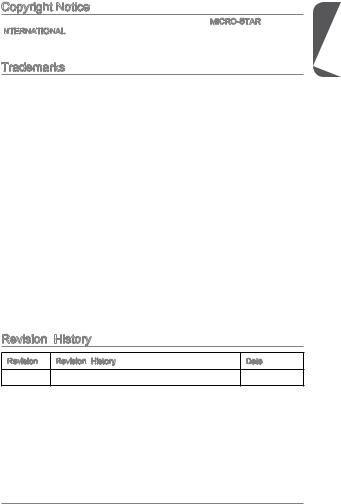
Copyright Notice
The material in this document is the intellectual property of MICRO-STAR INTERNATIONAL. We take every care in the preparation of this document, but no guarantee is given as to the correctness of its contents. Our products are under continual improvement and we reserve the right to make changes without notice.
We take every care in the preparation of this document, but no guarantee is given as to the correctness of its contents. Our products are under continual improvement and we reserve the right to make changes without notice.
Trademarks
All trademarks in this manual are properties of their respective owners.
MSI® is registered trademark of Micro-Star Int’l Co.,Ltd.
NVIDIA® is registered trademark of NVIDIA Corporation.
ATI® is registered trademark of AMD Corporation.
AMD® is registered trademarks of AMD Corporation.
Intel® is registered trademarks of Intel Corporation.
Windows® is registered trademarks of Microsoft Corporation.
AMI® is registered trademark of American Megatrends Inc.
Award® is a registered trademark of Phoenix Technologies Ltd.
Sound Blaster® is registered trademark of Creative Technology Ltd.
Realtek® is registered trademark of Realtek Semiconductor Corporation.
JMicron® is registered trademark of JMicron Technology Corporation.
Netware® is registered trademark of Novell, Inc.
Lucid® is trademark of LucidLogix Technologies, Ltd.
VIA® is registered trademark of VIA Technologies, Inc.
ASMedia® is registered trademark of ASMedia Technology Inc.
iPad, iPhone, and iPod are trademarks of Apple Inc.
Qualcomm Atheros and Killer are trademarks of Qualcomm Atheros Inc.
Revision |
History |
|
Revision |
Revision History |
Date |
V3.0 |
First release |
2013/12 |
G52-78171X5
Preface
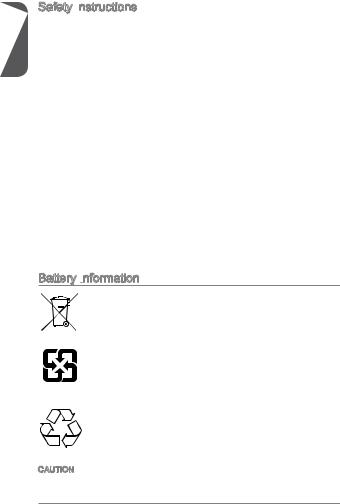
Safety Instructions
Preface |
Always read the safety instructions carefully. |
|
|
Keep this User’s Manual for future reference. |
|
|
Keep this equipment away from humidity. |
|
|
Lay this equipment on a reliable flat surface before setting it up. |
|
|
The openings on the enclosure are for air convection hence protects the |
|
|
|
equipment from overheating. DO NOT COVER THE OPENINGS. |
|
Make sure the voltage of the power source is at 110/220V before connecting the |
|
|
|
equipment to the power inlet. |
|
Place the power cord such a way that people can not step on it. Do not place |
|
|
|
anything over the power cord. |
|
Always Unplug the Power Cord before inserting any add-on card or module. |
|
|
All cautions and warnings on the equipment should be noted. |
|
|
Never pour any liquid into the opening that can cause damage or cause electrical |
|
|
|
shock. |
|
If any of the following situations arises, get the equipment checked by service |
|
|
|
personnel: |
|
|
The power cord or plug is damaged. |
|
|
Liquid has penetrated into the equipment. |
|
|
The equipment has been exposed to moisture. |
|
|
The equipment does not work well or you can not get it work according to |
|
|
User’s Manual. |
|
|
The equipment has been dropped and damaged. |
|
|
The equipment has obvious sign of breakage. |
|
DO NOT LEAVE THIS EQUIPMENT IN AN ENVIRONMENT ABOVE 60oC |
|
|
|
(140oF), IT MAY DAMAGE THE EQUIPMENT. |
Battery Information
European Union:
Batteries, battery packs, and accumulators should not be disposed of as unsorted household waste. Please use the public collection system to return, recycle, or treat them in compliance with the local regulations.
Taiwan:
For better environmental protection, waste batteries should be collected separately for recycling or special disposal.
California, USA:
The button cell battery may contain perchlorate material and requires special handling when recycled or disposed of in California.
For further information please visit: http://www.dtsc.ca.gov/hazardouswaste/perchlorate/
CAUTION: There is a risk of explosion, if battery is incorrectly replaced.
Replace only with the same or equivalent type recommended by the manufacturer.
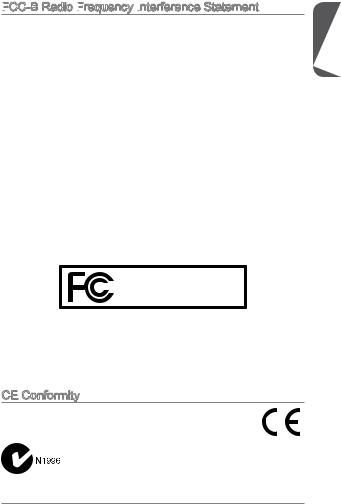
FCC
 -B Radio Frequency
-B Radio Frequency
 Interference
Interference Statement
Statement
This equipment has been tested and found to comply with the limits for a Class B digital device, pursuant to Part 15 of the FCC Rules. These limits are designed to provide reasonable protection against harmful interference in a residential installation. This equipment generates, uses and can radiate radio frequency
energy and, if not installed and used in accordance with the instructions, may cause harmful interference to radio communications. However, there is no guarantee that interference will not occur in a particular installation. If this equipment does cause harmful interference to radio or television reception, which can be determined
by turning the equipment off and on, the user is encouraged to try to correct the interference by one or more of the measures listed below.
Reorient or relocate the receiving antenna.
Increase the separation between the equipment and receiver.
Connect the equipment into an outlet on a circuit different from that to which the receiver is connected.
Consult the dealer or an experienced radio/television technician for help. Notice 1
The changes or modifications not expressly approved by the party responsible for compliance could void the user’s authority to operate the equipment.
Notice 2
Shielded interface cables and A.C. power cord, if any, must be used in order to comply with the emission limits.
VOIR LA NOTICE D’INSTALLATION AVANT DE RACCORDER AU RESEAU.
Micro-Star International
MS-7817
This device complies with Part 15 of the FCC Rules. Operation is subject to the following two conditions:
) this device may not cause harmful interference, and
2)this device must accept any interference received, including interference that may cause undesired operation.
CE Conformity
Conformity
Hereby, Micro-Star International CO., LTD declares that this device is in compliance with the essential safety requirements and other relevant provisions set out in the European Directive.
Preface
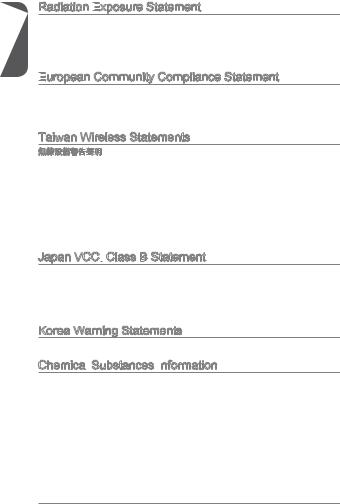
Preface
Radiation Exposure
 Statement
Statement
This equipment complies with FCC radiation exposure limits set forth for an uncontrolled environment. This equipment and its antenna should be installed and operated with minimum distance 20 cm between the radiator and your body. This equipment and its antenna must not be co-located or operating in conjunction with any other antenna or transmitter.
European
 Community Compliance Statement
Community Compliance Statement
The equipment complies with the RF Exposure Requirement 1999/519/EC, Council Recommendation of 12 July 1999 on the limitation of exposure of the general public to electromagnetic fields (0–300GHz). This wireless device complies with the R&TTE Directive.
Taiwan Wireless Statements
頻率、加大功率或變更原設計之特性及功能。
無線電通信。低功率射頻電機須忍受合法通信或工業、科學及醫療用電波輻射性電機 設備之干擾。
:
Japan VCCI Class B Statement
Class B Statement
B
VCCIB
Korea Warning Statements
Chemical Substances Information
Substances Information
In compliance with chemical substances regulations, such as the EU REACH Regulation (Regulation EC No. 1907/2006 of the European Parliament and the Council), MSI provides the information of chemical substances in products at:
http://www.msi.com/html/popup/csr/evmtprtt_pcm.html




< >
|
|
|
|
|
|||
|
|
|
|
|
|
|
|
|
|
|
|
|
|
||
|
|||||||
|
(Pb) |
(Hg) |
(Cd) |
(Cr6+) |
(PBB) |
(PBDE) |
|
|
|
|
|
|
|
|
|
* |
|
|
|
|
|
|
|
|
|
|
|
|
|
|
|
** |
|
|
|
|
|
|
|
|
|
|
|
|
|
|
|
|
|
|
|
|
|
|
|
|
|
|
|
|
|
|
|
|
|
|
|
|
|
|
|
|
|
|
|
|
|
|
|
: SJ/T11363-2006
: SJ/T113632006 RoHS
* : **
Preface
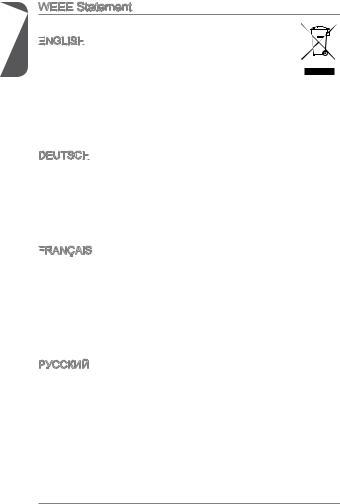
Preface
WEEE Statement
Statement
WEEE (Waste Electrical and Electronic Equipment)
ENGLISH


To protect the global environment and as an environmentalist, MSI must remind you that...
Under the European Union (“EU”) Directive on Waste Electrical and
Electronic Equipment, Directive 2002/96/EC, which takes effect on August 13, 2005, products of “electrical and electronic equipment” cannot be discarded as municipal wastes anymore, and manufacturers of covered electronic equipment will be obligated to take back such products at the end of their useful life. MSI will comply with the product take back requirements at the end of life of MSI-branded products that are sold into the EU. You can return these products to local collection points.
DEUTSCH
Hinweis von MSI zur Erhaltung und Schutz unserer Umwelt
Gemäß der Richtlinie 2002/96/EG über Elektround Elektronik-Altgeräte dürfen Elektround Elektronik-Altgeräte nicht mehr als kommunale Abfälle entsorgt werden. MSI hat europaweit verschiedene Sammelund Recyclingunternehmen beauftragt, die in die Europäische Union in Verkehr gebrachten Produkte, am Ende seines Lebenszyklus zurückzunehmen. Bitte entsorgen Sie dieses Produkt zum gegebenen Zeitpunkt ausschliesslich an einer lokalen Altgerätesammelstelle in Ihrer Nähe.
FRANÇAIS

En tant qu’écologiste et afin de protéger l’environnement, MSI tient à rappeler ceci...
Au sujet de la directive européenne (EU) relative aux déchets des équipement électriques et électroniques, directive 2002/96/EC, prenant effet le 13 août 2005, que les produits électriques et électroniques ne peuvent être déposés dans les décharges ou tout simplement mis à la poubelle. Les fabricants de ces équipements seront obligés de récupérer certains produits en fin de vie. MSI prendra en compte cette exigence relative au retour des produits en fin de vie au sein de la communauté européenne. Par conséquent vous pouvez retourner localement ces matériels dans les points de collecte.
РУССКИЙ
Компания MSI предпринимает активные действия по защите окружающей среды, поэтому напоминаем вам, что....
В соответствии с директивой Европейского Союза (ЕС) по предотвращению загрязнения окружающей среды использованным электрическим и электронным оборудованием (директива WEEE 2002/96/EC), вступающей в силу 13
августа 2005 года, изделия, относящиеся к электрическому и электронному оборудованию, не могут рассматриваться как бытовой мусор, поэтому производители вышеперечисленного электронного оборудования обязаны принимать его для переработки по окончании срока службы. MSI обязуется соблюдать требования по приему продукции, проданной под маркой MSI на территории EC, в переработку по окончании срока службы. Вы можете вернуть эти изделия в специализированные пункты приема.
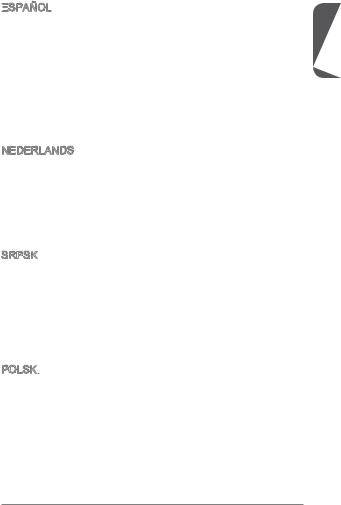
ESPAÑOL


MSI como empresa comprometida con la protección del medio ambiente, recomienda:
Bajo la directiva 2002/96/EC de la Unión Europea en materia de desechos y/o equipos electrónicos, con fecha de rigor desde el 13 de agosto de 2005, los productos clasificados como “eléctricos y equipos electrónicos” no pueden ser depositados en los contenedores habituales de su municipio, los fabricantes de equipos electrónicos, están obligados a hacerse cargo de dichos productos al termino de su período de vida. MSI estará comprometido con los términos de recogida de sus productos vendidos en la Unión Europea al final de su periodo de vida. Usted debe depositar estos productos en el punto limpio establecido por el ayuntamiento de su localidad o entregar a una empresa autorizada para la recogida de estos residuos.
NEDERLANDS
Om het milieu te beschermen, wil MSI u eraan herinneren dat….
De richtlijn van de Europese Unie (EU) met betrekking tot Vervuiling van Electrische en Electronische producten (2002/96/EC), die op 13 Augustus 2005 in zal gaan kunnen niet meer beschouwd worden als vervuiling. Fabrikanten van dit soort producten worden verplicht om producten retour te nemen aan het eind van hun levenscyclus. MSI zal overeenkomstig de richtlijn handelen voor de producten
die de merknaam MSI dragen en verkocht zijn in de EU. Deze goederen kunnen geretourneerd worden op lokale inzamelingspunten.
SRPSKI
Da bi zaštitili prirodnu sredinu, i kao preduzeće koje vodi računa o okolini i prirodnoj sredini, MSI mora da vas podesti da…
Po Direktivi Evropske unije (“EU”) o odbačenoj ekektronskoj i električnoj opremi, Direktiva 2002/96/EC, koja stupa na snagu od 13. Avgusta 2005, proizvodi koji spadaju pod “elektronsku i električnu opremu” ne mogu više biti odbačeni kao običan otpad i proizvođači ove opreme biće prinuđeni da uzmu natrag ove proizvode na kraju njihovog uobičajenog veka trajanja. MSI će poštovati zahtev o preuzimanju ovakvih proizvoda kojima je istekao vek trajanja, koji imaju MSI oznaku i koji su prodati u EU. Ove proizvode možete vratiti na lokalnim mestima za prikupljanje.
POLSKI

Aby chronić nasze środowisko naturalne oraz jako firma dbająca o ekologię, MSI przypomina, że...
Zgodnie z Dyrektywą Unii Europejskiej (“UE”) dotyczącą odpadów produktów elektrycznych i elektronicznych (Dyrektywa 2002/96/EC), która wchodzi w życie 13 sierpnia 2005, tzw. “produkty oraz wyposażenie elektryczne i elektroniczne “ nie mogą być traktowane jako śmieci komunalne, tak więc producenci tych produktów będą zobowiązani do odbierania ich w momencie gdy produkt jest wycofywany z użycia. MSI wypełni wymagania UE, przyjmując produkty (sprzedawane na terenie Unii Europejskiej) wycofywane z użycia. Produkty MSI będzie można zwracać w wyznaczonych punktach zbiorczych.
Preface
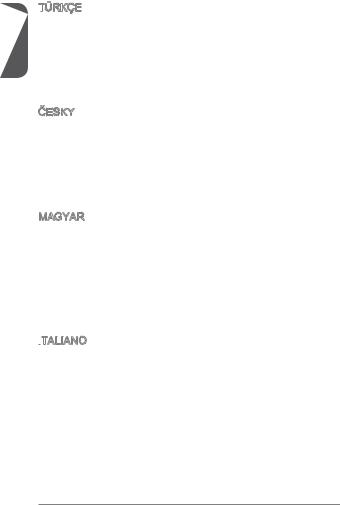
Preface
TÜRKÇE

Çevreci özelliğiyle bilinen MSI dünyada çevreyi korumak için hatırlatır:
Avrupa Birliği (AB) Kararnamesi Elektrik ve Elektronik Malzeme Atığı, 2002/96/EC Kararnamesi altında 13 Ağustos 2005 tarihinden itibaren geçerli olmak üzere, elektrikli ve elektronik malzemeler diğer atıklar gibi çöpe atılamayacak ve bu elektonik cihazların üreticileri, cihazların kullanım süreleri bittikten sonra ürünleri geri toplamakla yükümlü olacaktır. Avrupa Birliği’ne satılan MSI markalı ürünlerin kullanım süreleri bittiğinde MSI ürünlerin geri alınması isteği ile işbirliği içerisinde olacaktır. Ürünlerinizi yerel toplama noktalarına bırakabilirsiniz.
ČESKY
Záleží nám na ochraně životního prostředí - společnost MSI upozorňuje...
Podle směrnice Evropské unie (“EU”) o likvidaci elektrických a elektronických výrobků 2002/96/EC platné od 13. srpna 2005 je zakázáno likvidovat “elektrické a elektronické výrobky” v běžném komunálním odpadu a výrobci elektronických
výrobků, na které se tato směrnice vztahuje, budou povinni odebírat takové výrobky zpět po skončení jejich životnosti. Společnost MSI splní požadavky na odebírání výrobků značky MSI, prodávaných v zemích EU, po skončení jejich životnosti. Tyto výrobky můžete odevzdat v místních sběrnách.
MAGYAR
Annak érdekében, hogy környezetünket megvédjük, illetve környezetvédőként fellépve az MSI emlékezteti Önt, hogy ...
Az Európai Unió („EU”) 2005. augusztus 13-án hatályba lépő, az elektromos és elektronikus berendezések hulladékairól szóló 2002/96/EK irányelve szerint az elektromos és elektronikus berendezések többé nem kezelhetőek lakossági hulladékként, és az ilyen elektronikus berendezések gyártói kötelessé válnak az ilyen termékek visszavételére azok hasznos élettartama végén. Az MSI betartja a termékvisszavétellel kapcsolatos követelményeket az MSI márkanév alatt az EU-n belül értékesített termékek esetében, azok élettartamának végén. Az ilyen termékeket a legközelebbi gyűjtőhelyre viheti.
ITALIANO

Per proteggere l’ambiente, MSI, da sempre amica della natura, ti ricorda che….
In base alla Direttiva dell’Unione Europea (EU) sullo Smaltimento dei Materiali Elettrici ed Elettronici, Direttiva 2002/96/EC in vigore dal 13 Agosto 2005, prodotti appartenenti alla categoria dei Materiali Elettrici ed Elettronici non possono più essere eliminati come rifiuti municipali: i produttori di detti materiali saranno obbligati a ritirare ogni prodotto alla fine del suo ciclo di vita. MSI si adeguerà a tale Direttiva ritirando tutti i prodotti marchiati MSI che sono stati venduti all’interno dell’Unione Europea alla fine del loro ciclo di vita. È possibile portare i prodotti nel più vicino punto di raccolta

Contents
English 11
Motherboard Specifications 12 Back Panel 14 CPU & Heatsink Installation 15 Memory Installation 17 Internal Connectors 18 BIOS Setup 25
33
3436 CPU 373940 BIOS 47
Français 55
Spécifications 56 Panneau Arrière 58 Installation du CPU et son ventilateur 59 Installation de mémoire 61 Connecteurs d’alimentation 62 Configuration BIOS 69
Deutsch 77
Spezifikationen 78 Rücktafel-Übersicht 80 CPU & Kühlkörper Einbau 81 Speicher 83 Interne Anschlüsse 84 BIOS Setup 91
Русский 99
Характеристики материнской платы 100 Задняя панель 102 Установка ЦП и радиатора 103 Установка памяти 105 Внутренние разъемы 106 Настройка BIOS 113
Preface

Preface
121
122124 CPU & 125127128 BIOS Setup BIOS 135
141
142144CPU 145147148 BIOS 155
161
162 I/O 164 CPU 165167168 BIOS 175
10
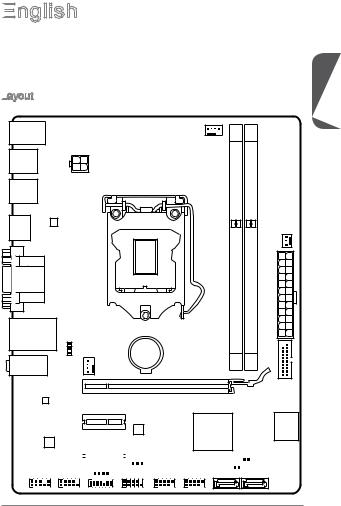
English

Thank you for choosing the H81M-E34 Series (MS-7817 v3.X) Micro-ATX motherboard. The H81M-E34 Series motherboards are based on Intel H81 chipset for optimal system efficiency. Designed to fit the advanced Intel LGA1150 processor, the H81M-E34 Series motherboards deliver a high performance and professional desktop platform solution.
Layout
Top : mouse
Bottom: keyboard
JPWR2
USB3.0 ports
USB3.0 ports
HDMI port
Top: VGA port |
Bottom: DVI port |
Top: LAN jack
Bottom: USB2.0 ports JUSB_PW1
SYSFAN1 BAT1
CPUFAN |
|
|
SYSFAN2 |
DIMM1 |
DIMM2 |
JPWR1 |
T:Line-In |
JUSB3 |
B:MIC-Int |
|
M:LineOut |
|
PCI_E1 |
|
PCI_E2 |
|
PCI_E3 |
SATA1_2 |
|
|
|
|
|
|
|
|
|
|
|
|
|
|
|
|
|
|
|
JCI1 |
|
|
|
JFP2 |
|
|
|
JUSB_PW2 |
JBAT1 |
|||||||||||
|
|
|
|
|
|
|
|
|
|
|
|
|
SATA4 |
|
|
|
SATA3 |
||
|
|
|
|
|
|
|
|
|
|
|
|
|
|
|
|
||||
JAUD1 |
JCOM1 |
JTPM1 |
JFP1 |
JUSB2 |
JUSB1 |
English
11
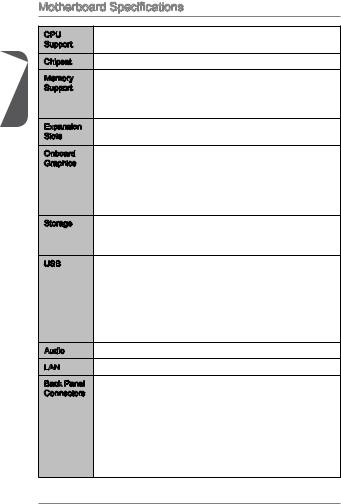
English
Motherboard Specifications
CPU |
■ |
4th Generation Intel® Core™ i7 / Core™ i5 / Core™ i3 / |
|
Support |
|
Pentium® / Celeron® processors for LGA 1150 socket |
|
Chipset |
■ |
Intel® H81 Express Chipset |
|
Memory |
■ 2x |
DDR3 memory slots supporting up to 16GB |
|
Support |
■ Supports DDR3 1600/ 1333/ 1066 MHz |
||
|
■ |
Dual channel memory architecture |
|
|
■ |
Supports non-ECC, un-buffered memory |
|
Expansion |
■ |
1x |
PCIe 2.0 x16 slot |
Slots |
■ |
2x |
PCIe 2.0 x1 slots |
Onboard |
■ |
1x |
HDMI port, supporting a maximum resolution of |
Graphics |
|
2560x1600@60Hz, 24bpp/ 1920x1080@60Hz, 36bpp |
|
■1x DVI-D port, supporting a maximum resolution of 1920x1200
@60Hz, 24bpp
■1x VGA port, supporting a maximum resolution of 1920x1200
@60Hz, 24bpp
Storage |
■ Intel H81 Express Chipset |
-2x SATA 6Gb/s ports (SATA1~2)
-2x SATA 3Gb/s ports (SATA3~4)
USB |
■ Intel H81 Express Chipset |
-2x USB 3.0 ports available through an onboard USB 3.0 connector
-6x USB 2.0 ports (2 ports on the back panel, 4 ports available through the internal USB connectors)
■VIA VL805 Chipset
-4x USB 3.0 ports on the back panel
Audio |
■ Realtek® ALC887 Codec |
||
LAN |
■ |
Realtek® RTL8111G Gigabit LAN controller |
|
Back Panel |
■ |
1x |
PS/2 keyboard port |
Connectors |
■ |
1x |
PS/2 mouse port |
|
■ |
2x |
USB 2.0 ports |
|
■ |
4x |
USB 3.0 ports |
|
■ 1x |
HDMI port |
|
|
■ |
1x |
DVI-D port |
|
■ 1x |
VGA port |
|
|
■ |
1x |
LAN (RJ45) port |
|
■ |
3x audio jacks |
|
12

Internal |
■ |
1x |
24-pin ATX main power connector |
Connectors |
■ |
1x |
4-pin ATX 12V power connector |
■2x SATA 6Gb/s connectors
■2x SATA 3Gb/s connectors
■2x USB 2.0 connectors (supports additional 4 USB 2.0 ports)
■1x USB 3.0 connector (supports additional 2 USB 3.0 ports)
■1x 4-pin CPU fan connector
■1x 4-pin system fan connector
■1x 3-pin system fan connector
■1x Front panel audio connector
■2x System panel connectors
■1x Chassis Intrusion connector
■1x TPM module connector
■1x Serial port connector
■1x Clear CMOS jumper
■2x USB power jumpers
BIOS |
■ UEFI AMI BIOS |
|
Features |
■ |
ACPI 5.0, PnP 1.0a, SM BIOS 2.7, DMI 2.0 |
|
■ |
Multi-language |
Form Factor |
■ |
Micro-ATX Form Factor |
|
■ |
8.9 in. x 6.8 in. (22.6 cm x 17.3 cm) |
For the latest information about CPU, please visit
http://www.msi.com/service/cpu-support/
For more information on compatible components, please visit http://www.msi.com/service/test-report/
English
13
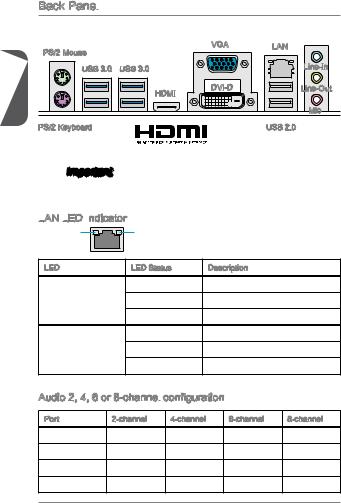
Back Panel
|
PS/2 Mouse |
|
VGA |
LAN |
|
|
|
|
|
English |
USB 3.0 |
USB 3.0 |
|
Line-In |
|
HDMI |
DVI-D |
Line-Out |
|
|
|
|
||
|
|
|
Mic |
|
|
|
|
|
|
|
PS/2 Keyboard |
|
® |
USB 2.0 |
 Important
Important
The USB 3.0 ports on the back panel do not support wake-up function.
LAN
 LED
LED
 Indicator
Indicator
LINK/ACT |
SPEED |
|
LED |
LED |
|
LED |
LED Status |
Description |
|
Off |
No link |
Link/ Activity LED |
Yellow |
Linked |
|
Blinking |
Data activity |
|
Off |
10 Mbps connection |
Speed LED |
Green |
100 Mbps connection |
|
Orange |
1 Gbps connection |
Audio 2, 4, 6 or 8-channel
 configuration
configuration
Port |
2-channel |
4-channel |
6-channel |
8-channel |
Blue |
Line in |
RS-Out |
RS-Out |
RS-Out |
Green |
Line out |
FS-Out |
FS-Out |
FS-Out |
Pink |
Mic |
Mic |
CS-Out |
CS-Out |
Front audio |
- |
- |
- |
SS-Out |
14
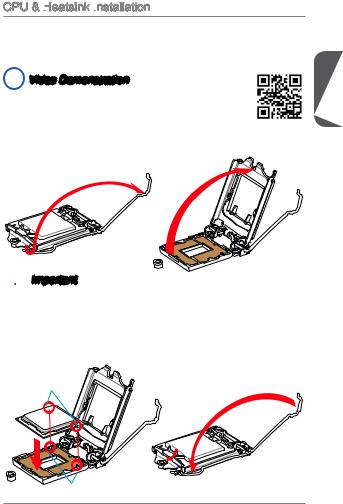
CPU & Heatsink Installation
Installation
When installing a CPU, always remember to install a CPU heatsink. A CPU heatsink is necessary to prevent overheating and maintain system stability. Follow the steps below to ensure correct CPU and heatsink installation. Wrong installation can damage both the CPU and the motherboard.
 Video Demonstration
Video Demonstration
Watch the video to learn how to install CPU & heatsink. at the address below.
http://youtu.be/bf5La099urI
1.Push the load lever down to unclip it and lift to the fully open position.
2.The load plate will automatically lift up as the load lever is pushed to the fully open position.
 Important
Important
Do not touch the socket contacts or the bottom of the CPU.
3.Align the notches with the socket alignment keys. Lower the CPU straight down, without tilting or sliding the CPU in the socket. Inspect the CPU to check if it is properly seated in the socket.
4.Close and slide the load plate under the retention knob. Close and engage the load lever.
CPU notches
Alignment Key
English
15
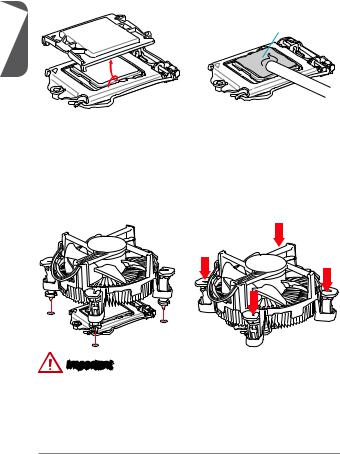
English
5.When you press down the load lever the PnP cap will automatically pop up from the CPU socket. Do not discard the PnP cap. Always replace the PnP cap if the CPU is removed from the socket.
6.Evenly spread a thin layer of thermal paste (or thermal tape) on the top of the CPU. This will help in heat dissipation and prevent CPU overheating.
Thermal paste
7.Locate the CPU fan connector on the motherboard.
8.Place the heatsink on the motherboard with the fan’s cable facing towards the fan connector and the fasteners matching the holes on the motherboard.
9.Push down the heatsink until the four fasteners get wedged into the holes on the motherboard. Press the four fasteners down to fasten the heatsink. As each fastener locks into position a click should be heard.
10.Inspect the motherboard to ensure that the fastener-ends have been properly locked in place.
11.Finally, attach the CPU fan cable to the CPU fan connector on the motherboard.
Important
•Confirm that the CPU heatsink has formed a tight seal with the CPU before booting your system.
•Whenever the CPU is not installed, always protect the CPU socket pins by covering the socket with the plastic cap.
•If you purchased a separate CPU and heatsink/ cooler, Please refer to the documentation in the heatsink/ cooler package for more details about installation.
16

Memory Installation
 Video Demonstration
Video Demonstration
Watch the video to learn how to install memories at the address below. http://youtu.be/76yLtJaKlCQ
1
2
3
 Important
Important
•DDR3 memory modules are not interchangeable with DDR2, and the DDR3 standard is not backward compatible. Always install DDR3 memory modules in DDR3 DIMM slots.
•To ensure system stability, memory modules must be of the same type and density in Dual-Channel mode.
English
17
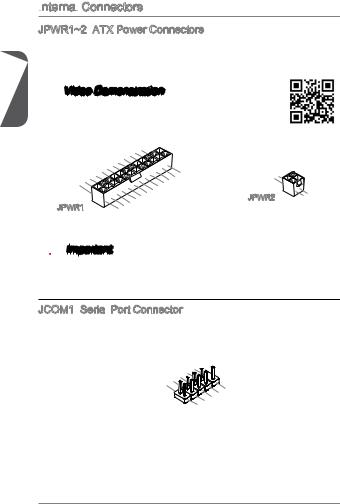
English
Internal
 Connectors
Connectors
JPWR1~2: ATX Power Connectors
ATX Power Connectors
These connectors allow you to connect an ATX power supply. To connect the ATX power supply, align the power supply cable with the connector and firmly press the cable into the connector. If done correctly, the clip on the power cable should be hooked on the motherboard’s power connector.
 Video Demonstration
Video Demonstration
Watch the video to learn how to install power supply connectors. http://youtu.be/gkDYyR_83I4
|
|
|
|
|
12. |
|
|
|
|
|
|
|
|
11 |
. +3 |
. |
|
|
|
|
|
910. |
||||
|
|
|
|
7 |
. |
+12V |
3V |
|
|
|
|
|
8 |
|
|
||
|
|
|
6 . |
|
|
|
|
|
|
5 . |
|
|
|
|
|||
1 |
4 |
|
. +5 |
|
|
|
|
|
3 . |
Ground |
|
|
|
|
|||
2 . +5 |
|
|
|
|
|
|||
+3.Ground |
|
|
|
|
||||
|
. |
|
|
V |
|
|
|
|
. +3. |
|
|
|
|
|
|
||
|
3 |
|
|
|
|
|
|
|
|
3 |
V |
|
|
|
|
|
|
|
V |
|
|
|
|
|
|
|
JPWR1 |
. |
- |
|
|
|
+3.Ground |
|
||
|
13. |
- |
ON |
# |
|
|
12V |
|
|
|
|
3 |
|
|
|
|
V |
|
|
24. |
||
23. |
|
|
|
Ground |
|
. +5 |
V |
|
+5 |
|
|
+5 |
V |
|
V |
|
|
|
1 |
|
. |
2 |
Ground |
. |
|
Ground |
|
JPWR2
|
3 |
|
. |
4 |
+12V |
. |
|
+12V |
|
 Important
Important
Make sure that all the power cables are securely connected to a proper ATX power supply to ensure stable operation of the motherboard.
JCOM1: Serial
Serial Port Connector
Port Connector
This connector is a 16550A high speed communication port that sends/receives 16 bytes FIFOs. You can attach a serial device.
|
|
|
|
|
1 |
|
|
|
|
|
|
|
|
|
|
|
0 |
|
|
|
|
|
|
|
|
8 . |
|
|
||||
|
|
6 |
|
. N |
|
|||||
|
|
|
|
C |
|
o |
|
|||
|
4 |
. |
|
|
T |
|
|
|||
|
|
D |
|
|
S Pi |
|||||
2 |
|
. |
|
|
S |
|
|
|
n |
|
|
D |
|
|
R |
|
|
|
|||
. |
|
T |
|
|
|
|
|
|
||
S |
|
R |
|
|
|
|
|
|||
|
|
I |
|
|
|
|
|
|
||
|
|
N |
|
|
|
|
|
|
|
|
|
|
|
|
|
|
|
|
9 |
|
||
|
|
|
|
|
7 |
|
. |
|
|||
|
|
|
|
|
|
|
R |
||||
|
|
|
5 |
|
|
. |
|
|
I |
||
|
|
|
|
|
|
R |
|
|
|||
|
3 |
|
. |
|
|
T |
|
||||
|
|
|
G |
|
|
S |
|||||
1 |
|
. |
|
|
|
r |
|
||||
|
|
S |
|
|
|
o |
|
|
|||
. |
|
O |
|
|
u |
|
|||||
D |
|
|
|
U |
|
n |
|||||
|
|
C |
|
|
|
|
d |
||||
|
|
|
|
|
|
T |
|
|
|||
|
|
|
D |
|
|
|
|
|
|
||
18
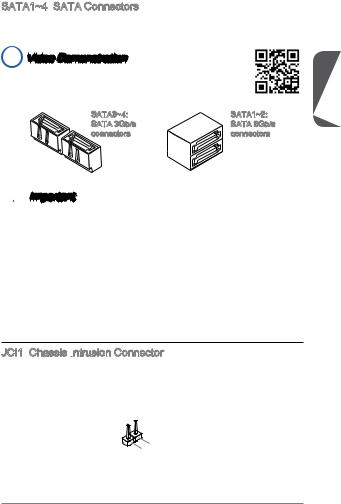
SATA1~4: SATA Connectors
SATA Connectors
This connector is a high-speed SATA interface port. Each connector can connect to one SATA device. SATA devices include disk drives (HDD), solid state drives (SSD), and optical drives (CD/ DVD/ Blu-Ray).
 Video Demonstration
Video Demonstration
Watch the video to learn how to Install SATA HDD. http://youtu.be/RZsMpqxythc
SATA3~4: |
SATA1~2: |
SATA 3Gb/s |
SATA 6Gb/s |
connectors |
connectors |
 Important
Important
•Many SATA devices also need a power cable from the power supply. Such devices include disk drives (HDD), solid state drives (SSD), and optical drives (CD / DVD / Blu-Ray). Please refer to the device’s manual for further information.
•Many computer cases also require that large SATA devices, such as HDDs, SSDs, and optical drives, be screwed down into the case. Refer to the manual that came with your computer case or your SATA device for further installation instructions.
•Please do not fold the SATA cable at a 90-degree angle. Data loss may result during transmission otherwise.
•SATA cables have identical plugs on either sides of the cable. However, it is recommended that the flat connector be connected to the motherboard for space saving purposes.
JCI1: Chassis Intrusion
Chassis Intrusion
 Connector
Connector
This connector connects to the chassis intrusion switch cable. If the computer case is opened, the chassis intrusion mechanism will be activated. The system will record this intrusion and a warning message will flash on screen. To clear the warning, you must enter the BIOS utility and clear the record.
English
|
1 |
|
|
|
|
||
2 |
|
. |
|
|
|
|
|
|
|
G |
|
|
|
||
. |
|
|
r |
|
|
||
C |
|
|
o |
|
|
||
|
|
I |
|
u |
|
||
|
|
|
N |
|
n |
||
|
|
|
|
T |
|
d |
|
|
|
|
|
|
R |
|
|
|
|
|
|
|
U |
||
19
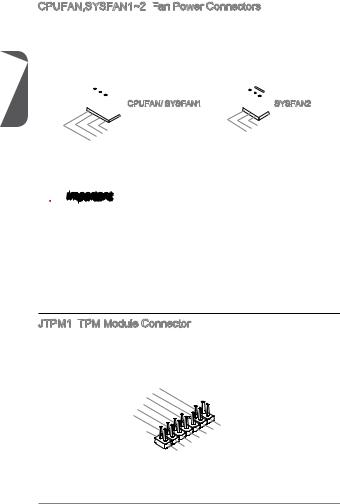
English
CPUFAN,SYSFAN1~2: Fan
Fan Power Connectors
Power Connectors
The fan power connectors support system cooling fans with +12V. If the motherboard has a System Hardware Monitor chipset on-board, you must use a specially designed fan with a speed sensor to take advantage of the CPU fan control. Remember to connect all system fans. Some system fans may not connect to the motherboard and will instead connect to the power supply directly. A system fan can be plugged into any available system fan connector.
 CPUFAN/ SYSFAN1
CPUFAN/ SYSFAN1
|
1 |
|
2 . |
||
|
+12VGround |
|
3 . |
|
|
4 . |
|
|
Sens |
|
|
. |
|
|
Speed |
e |
|
|
|
C |
|
|
ontrol |
 SYSFAN2
SYSFAN2
1 . 2 . Ground 3 +12V . No Use
 Important
Important
•Please refer to your processor’s official website or consult your vendor to find recommended CPU heatsink.
•These connectors support Smart Fan Control with liner mode. The Command Center utility can be installed to automatically control the fan speeds according to the CPU’s and system’s temperature.
•If there are not enough ports on the motherboard to connect all system fans, adapters are available to connect a fan directly to a power supply.
•Before first boot up, ensure that there are no cables impeding any fan blades.
JTPM1:
 TPM Module Connector
TPM Module Connector
This connector connects to a TPM (Trusted Platform Module). Please refer to the TPM security platform manual for more details and usages.
|
|
|
|
|
|
|
14. |
|
|
|
|
|
|
12. |
|||
|
|
6 . |
No Ground |
|||||
4 |
|
|
10. |
GroundPi |
||||
|
. |
5V |
|
|
||||
. |
|
|
|
8 |
|
|
|
|
|
|
|
Serial |
|
|
|||
|
. |
3V |
|
P n |
||||
|
|
|
|
|
|
ower |
||
|
3 |
|
|
|
|
|
||
2 . |
|
|
IRQ |
|||||
3V |
|
|
|
P |
|
|||
|
|
Standby |
|
|||||
|
|
|
|
|
ower |
|||
|
|
|
|
|
|
|
|
p |
|
|
|
|
|
|
|
|
ower |
|
|
|
|
|
|
13. |
|
|
|
|
|
|
|
|
|
|
||
|
|
5 |
|
911 |
. LP |
|
|
|
|
|
|
|
|
|
||||
|
|
. LP LPC |
C |
|
|
|
|
|
|
|
||||||||
|
3 |
|
7 . |
|
a |
|
|
|
|
|
|
|
|
|||||
|
. LP |
|
|
|
a |
Fram |
|
|
|
|
||||||||
|
|
|
C |
|
|
|
|
|
|
|
|
|
||||||
|
. LP |
|
a |
|
|
|
|
|
ddres |
|
e |
|
|
|
||||
LP |
|
C |
C |
|
|
|
ddres |
|
s |
|
|
|
||||||
. LP |
|
|
a |
|
|
|
|
|
|
|
|
|
|
|
|
|||
1 |
|
|
|
|
|
|
|
|
|
|
|
|
|
|
|
|
|
|
|
|
C |
|
|
|
ddres |
|
|
|
|
|
|
|
|
||||
|
|
C |
|
ddres |
s |
|
& |
|
|
|
|
|
||||||
|
|
|
|
Reset |
|
|
|
& |
|
|
||||||||
|
|
|
|
|
|
|
|
|
|
|
|
|
s |
|
|
|
||
|
|
|
loc |
|
|
|
|
|
|
s & |
|
|
data |
|
||||
|
|
|
k |
|
|
|
|
& |
|
|
|
|
p |
|||||
|
|
|
|
|
|
|
|
|
|
|
data |
p |
||||||
|
|
|
|
|
|
|
|
|
|
|
|
|
data |
|
|
|||
|
|
|
|
|
|
|
|
|
|
|
|
data |
|
|
p in2 in3 |
|||
|
|
|
|
|
|
|
|
|
|
|
|
|
|
p in1 |
|
|||
|
|
|
|
|
|
|
|
|
|
|
|
|
|
|
in0 |
|
|
|
20
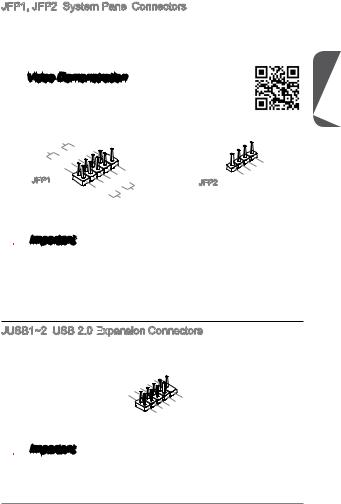
JFP1, JFP2: System Panel
System Panel Connectors
Connectors
These connectors connect to the front panel switches and LEDs. The JFP1 connector is compliant with the Intel® Front Panel I/O Connectivity Design Guide. When installing the front panel connectors, please use the optional M-Connector to simplify installation. Plug all the wires from the computer case into the M-Connector and then plug the M-Connector into the motherboard.
 Video Demonstration
Video Demonstration
Watch the video to learn how to Install front panel connectors. http://youtu.be/DPELIdVNZUI
|
P |
|
|
|
|
|
|
|
P |
ower |
S |
10. |
|
|
|||
|
|
|
|
|||||
ower |
LE |
witch |
|
|
No |
|
||
|
|
|
|
|
8Pi |
|||
|
|
|
D |
|
|
6 |
. n |
|
|
|
|
|
|
|
- |
||
|
|
|
4 |
. |
|
|
||
|
|
|
+ |
|
||||
|
|
|
2 |
. |
|
|
||
|
|
|
|
- |
|
|
||
|
|
|
. |
|
|
|
|
|
|
|
|
+ |
|
|
|
|
|
JFP1
|
|
|
|
|
|
|
9 |
|
|
|
|
||
1 |
|
|
|
|
|
|
|
. |
|
|
|
|
|
|
|
|
7 |
|
|
Reserve |
|
||||||
|
|
|
5 |
|
. |
|
|
|
|
|
|
||
|
|
|
|
|
+ |
|
|
|
|
|
|||
|
3 |
. |
|
|
|
|
|
|
|
|
|
||
|
|
- |
|
|
|
|
|
|
|
|
|||
|
|
. |
|
|
|
|
|
|
|
|
|
|
|
. |
- |
|
|
|
|
|
Reset |
|
d |
||||
+ |
|
|
|
|
|
|
|
|
|||||
|
|
HDD |
|
|
|
|
|||||||
|
|
|
|
|
LE |
|
S |
||||||
|
|
|
|
|
|
|
|
|
|
D |
|
witch |
|
JFP2
|
|
|
|
4 |
|
1 |
|
|
|
|
. |
|
3 |
|
VCC5 |
||
|
|
|
. |
|
|
|
VCC5Speaker |
||||
|
2 |
|
|
|
|
|
. |
|
|
|
|
. |
|
|
|
|
|
Speaker |
|||||
 Important
Important
•On the connectors coming from the case, pins marked by small triangles are positive wires. Please use the diagrams above and the writing on the optional M- Connectors to determine correct connector orientation and placement.
•The majority of the computer case’s front panel connectors will primarily be plugged into JFP1.
JUSB1~2: USB 2.0 Expansion
USB 2.0 Expansion
 Connectors
Connectors
This connector is designed for connecting high-speed USB peripherals such as USB HDDs, digital cameras, MP3 players, printers, modems, and many others.
|
|
|
|
|
|
|
1 |
|
|
|
|
||
|
|
|
|
|
|
|
|
|
0 |
|
|
|
|
|
|
|
6 |
8 . |
|
|
|||||||
|
|
|
|
|
G NC |
|
|||||||
|
|
|
|
. |
. |
r |
|
|
|||||
|
4 |
|
|
|
|
|
|
||||||
|
|
|
U |
|
|
o |
|
|
|||||
|
|
. |
|
|
|
S |
|
u |
|
||||
2 |
|
U |
|
|
|
|
B |
|
|
d |
|||
. |
|
|
S |
|
|
|
1 |
|
|||||
V |
|
|
|
B |
|
|
+ |
|
|||||
|
|
C |
|
|
|
|
1 |
|
|
|
|
||
|
|
|
C |
|
|
|
- |
|
|
|
|||
|
|
|
|
|
|
|
9 |
|
|
|
|
|
||
|
|
|
|
7 |
. |
|
|
|
||||||
|
|
|
|
|
N |
|
|
|
||||||
|
|
5 |
|
|
. |
|
|
o |
|
|
||||
|
|
|
|
|
G |
|
|
Pi |
||||||
|
3 |
|
. |
|
|
|
r |
|||||||
|
|
|
U |
|
|
|
o |
|
|
n |
||||
1 |
. |
|
|
|
S |
|
|
u |
|
|
||||
U |
|
|
|
|
B |
|
n |
|
||||||
. |
|
S |
|
|
|
|
||||||||
V |
|
|
|
|
0 |
|
d |
|||||||
|
C |
|
|
B |
|
|
|
+ |
|
|
||||
|
|
|
|
|
0 |
|
|
|
|
|
|
|||
|
|
C |
|
|
|
- |
|
|
|
|
||||
 Important
Important
Note that the VCC and GND pins must be connected correctly to avoid possible damage.
English
21
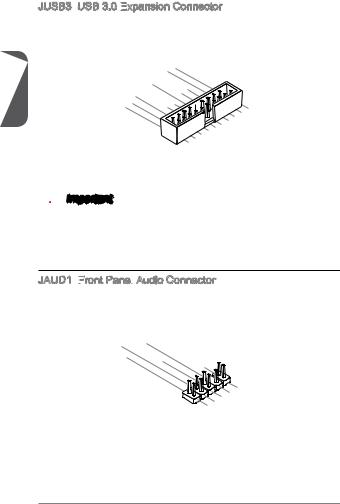
English
JUSB3: USB 3.0 Expansion
USB 3.0 Expansion
 Connector
Connector
The USB 3.0 port is backwards compatible with USB 2.0 devices. It supports data transfer rates up to 5Gbits/s (SuperSpeed).
|
|
|
|
|
|
|
|
|
20. |
|
|
|
|||
|
|
|
|
|
|
19. |
|
No |
|
|
|||||
|
|
|
|
|
18. |
|
|
|
|
||||||
|
|
|
|
16. |
|
|
|
Power |
|
||||||
|
|
|
|
17 |
. |
USB3 |
|
|
Pi |
n |
|||||
|
|
|
15. |
|
USB3 |
|
|
_ |
|
_ |
|||||
|
13. |
USB3Ground |
|
RX |
|
||||||||||
|
|
14. |
|
|
|
|
|
|
_ |
RX |
|
||||
12. |
USB3 |
|
_ |
|
|
C |
|
|
|
||||||
U |
|
Ground |
|
TX |
|
|
|
|
|
|
|||||
11. |
|
USB2 |
|
_ |
TX_ |
|
|
|
|
||||||
|
|
- |
|
|
|
_ |
|
|
|
|
|
|
|||
|
SB2. |
|
|
|
|
C |
|
|
|
|
|
||||
|
|
|
|
. |
|
|
|
|
|
|
|
|
|
||
|
|
|
0 |
0 |
|
|
|
|
|
_ |
|
|
|
|
|
|
|
|
|
|
|
|
|
|
|
DP |
|
|
|||
|
|
|
|
+ |
|
|
|
|
|
|
|
|
|
|
|
|
|
|
|
|
|
|
|
|
1 |
|
|
|
|
|
|
|
|
|
|
|
|
|
|
|
|
. |
|
|
|
|
|
||
|
|
|
|
|
|
|
|
. Power |
|
|||||||
|
|
|
|
|
|
|
|
USB3 |
_ |
|
||||||
|
|
|
|
|
|
|
|
USB3 |
|
|
_ |
|||||
|
|
|
|
|
|
SB3Ground |
|
|
RX |
|
||||||
|
|
|
USB3 |
|
|
|
|
_ |
|
RX |
DN |
|||||
|
|
|
|
TX |
|
|
|
|
|
|
|
|||||
|
. |
Ground |
|
|
|
|
|
|
|
_ |
|
|||||
|
|
|
|
|
|
|
_ |
|
|
|
|
|
|
|||
. |
U |
|
|
|
|
_ TX |
|
|
C |
|
DP |
|||||
|
SB2 |
|
|
|
|
|
|
|
|
|
|
|||||
|
SB2 |
|
|
0 |
|
|
|
_ |
_ |
|
||||||
|
|
|
|
|
C |
|
|
|||||||||
Ground |
|
. |
|
|
|
_ |
|
|
|
|
||||||
|
|
- |
|
|
_ |
|
DN |
|
||||||||
|
|
|
0 |
|
|
|
|
|
||||||||
|
|
|
. |
+ |
|
|
|
|
|
|
||||||
|
|
|
|
|
|
|
|
|
|
DP |
|
|
||||
 Important
Important
•Note that the VCC and GND pins must be connected correctly to avoid possible damage.
•To use a USB 3.0 device, you must connect the device to a USB 3.0 port through an optional USB 3.0 compliant cable.
JAUD1: Front
Front
 Panel
Panel
 Audio Connector
Audio Connector
This connector allows you to connect the front audio panel located on your computer case. This connector is compliant with the Intel® Front Panel I/O Connectivity Design Guide.
|
|
|
10. |
|
|
|
|
4 |
|
8 |
|
|
|
|
. NoHead |
|
|
|||
|
|
6 |
. |
|
|
|
|
|
|
Pi |
P |
|
|
|
. MI |
|
||||
2 |
NC |
D |
hone |
|
||
|
|
|
C n |
|
|
|
. |
|
|
|
|
|
|
Ground |
etection |
Detection |
||||
|
|
|
|
|
|
|
|
|
|
|
9 |
|
|
|
|
|
|
3 . |
. |
|
|
|
|
|||
|
|
Head |
|
|
|
|
|||
|
|
|
7 |
|
|
|
|
|
|
|
|
5 . |
|
|
|
|
|
||
. MIHeadSENSE |
P |
|
|
|
|||||
|
. |
|
R |
|
|
|
|
||
1 |
|
|
|
P |
hone |
|
|||
MI |
|
C |
|
_ |
|
|
|
||
|
|
L |
|
|
SEN |
|
L |
||
|
|
C |
|
|
hone |
|
|
||
|
|
|
|
|
R |
D |
|||
22
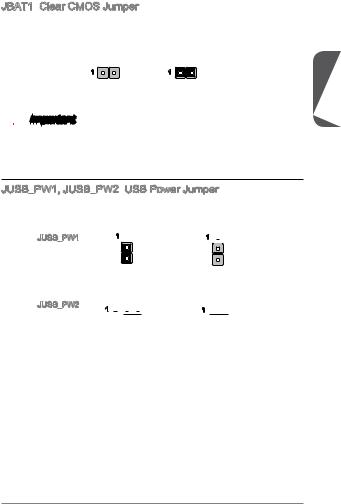
JBAT1: Clear CMOS Jumper
Clear CMOS Jumper
There is CMOS RAM onboard that is external powered from a battery located on the motherboard to save system configuration data. With the CMOS RAM, the system can automatically boot into the operating system (OS) every time it is turned on. If you want to clear the system configuration, set the jumpers to clear the CMOS RAM.
1 |
1 |
Keep Data |
Clear Data |
 Important
Important
You can clear the CMOS RAM by shorting this jumper while the system is off. Afterwards, open the jumper . Do not clear the CMOS RAM while the system is on because it will damage the motherboard.
JUSB_PW1, JUSB_PW2: USB Power Jumper
USB Power Jumper
These jumpers are used to assign which USB and PS/2 ports could support “Wake Up Event Setup” field of BIOS.
JUSB_PW1
(for back panel USB 2.0 ports & PS/2 ports)
JUSB_PW2
(for onboard USB 2.0/ 3.0 connectors)
1
Support
1

Support
1 
No Support (Default)
1 



No Support (Default)
English
23
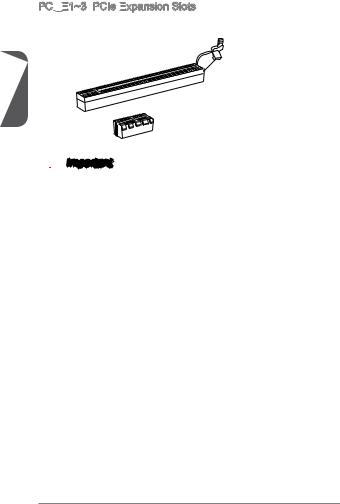
PCI _E1~3:
_E1~3:

 PCIe Expansion
PCIe Expansion
 Slots
Slots
The PCIe slot supports the PCIe interface expansion card.
English
PCIe 2.0 x16 Slot
PCIe 2.0 x1 Slot
 Important
Important
When adding or removing expansion cards, always turn off the power supply and unplug the power supply power cable from the power outlet. Read the expansion card’s documentation to check for any necessary additional hardware or software changes.
24
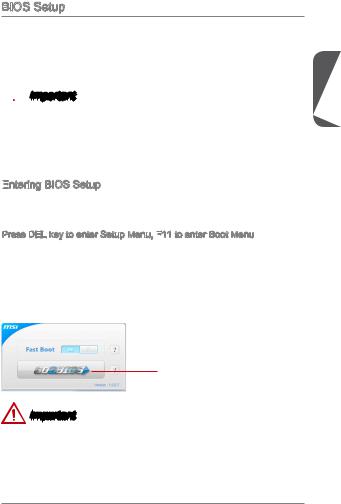
BIOS Setup
The default settings offer the optimal performance for system stability in normal conditions. You may need to run the Setup program when:
■An error message appears on the screen during the system booting up, and requests you to run SETUP.
■You want to change the default settings for customized features.
 Important
Important
•Please load the default settings to restore the optimal system performance and stability if the system becomes unstable after changing BIOS settings. Select the "Restore Defaults" and press <Enter> in BIOS to load the default settings.
•If you are unfamiliar with the BIOS settings, we recommend that you keep the default settings to avoid possible system damage or failure booting due to inappropriate BIOS configuration.
Entering
 BIOS Setup
BIOS Setup
Power on the computer and the system will start the Power On Self Test (POST) process. When the message below appears on the screen, please <DEL> key to enter BIOS:
Press DEL key to enter Setup Menu, F11
 to enter Boot Menu
to enter Boot Menu
If the message disappears before you respond and you still need to enter BIOS, restart the system by turning the computer OFF then back ON or pressing the RESET button. You may also restart the system by simultaneously pressing <Ctrl>, <Alt>, and <Delete> keys.
MSI additionally provides two methods to enter the BIOS setup. You can click the “GO2BIOS” tab on “MSI Fast Boot” utility screen or press the physical “GO2BIOS" button (optional) on the motherboard to enable the system going to BIOS setup directly at next boot.
Click "GO2BIOS" tab on "MSI Fast
Boot" utility screen.
Important
Please be sure to install the “MSI Fast Boot” utility before using it to enter the BIOS setup.
English
25
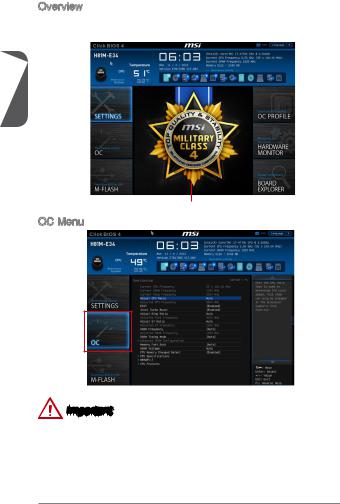
English
Overview
After entering BIOS, the following screen is displayed.
|
|
|
|
Temperature monitor |
Language |
|
|
System |
|||||||||||||||
Model name |
|
|
|
|
|
|
|
|
|
|
|
|
|
|
|
|
information |
||||||
|
|
|
|
|
|
|
|
|
|
|
|
|
|
|
|
||||||||
Virtual OC |
|
|
|
|
|
|
|
|
|
|
|
|
|
|
|
|
|
|
|
|
|
|
|
|
|
|
|
|
|
|
|
|
|
|
|
|
|
|
|
|
|
|
|
|
|
||
|
|
|
|
|
|
|
|
|
|
|
|
|
|
|
|
|
|
|
|
|
|||
Genie Button |
|
|
|
|
|
|
|
|
|
|
|
|
|
|
|
|
|||||||
|
|
|
|
|
|
|
|
|
|
|
|
|
|
|
|
|
|
|
Boot device |
||||
|
|
|
|
|
|
|
|
|
|
|
|
|
|
|
|
|
|
|
priority bar |
||||
BIOS menu |
|
|
|
|
|
|
|
|
|
|
|
|
|
|
|
|
|
|
|
|
|||
selection |
|
|
|
|
|
|
|
|
|
|
|
|
|
|
|
|
|
|
|
|
|||
|
|
|
|
|
|
|
|
|
|
|
|
|
|
|
|
|
|
|
|
|
|
|
|
|
|
|
|
|
|
|
|
|
|
|
|
|
|
|
|
|
|
|
|
|
|||
|
|
|
|
|
|
|
|
|
|
|
|
|
|
|
|
|
|
|
BIOS |
|
menu |
||
|
|
|
|
|
|
|
|
|
|
|
|
|
|
|
|
|
|
|
|
||||
|
|
|
|
|
|
|
|
|
|
|
|
|
|
|
|
|
|
|
selection |
||||
|
|
|
|
|
|
|
|
|
|
|
|
|
|
|
|
|
|
|
|
|
|
|
|
Menu display
OC Menu
Important
•Overclocking your PC manually is only recommended for advanced users.
•Overclocking is not guaranteed, and if done improperly, can void your warranty or severely damage your hardware.
•If you are unfamiliar with overclocking, we advise you to use OC Genie for easy overclocking.
26
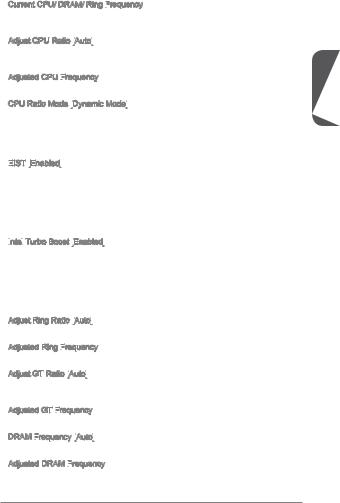
Current CPU/ DRAM/ Ring Frequency

These items show the current frequencies of installed CPU, Memory and Ring. Read-only.
Adjust CPU Ratio [Auto]



Sets the CPU ratio that is used to determine CPU clock speed. This item can only be changed if the processor supports this function.
Adjusted CPU Frequency

Shows the adjusted CPU frequency. Read-only.
CPU Ratio Mode [Dynamic
 Mode]
Mode]
 Selects the CPU Ratio operating mode.
Selects the CPU Ratio operating mode.
[Fixed Mode] |
Fixes the CPU ratio. |
[Dynamic Mode] |
CPU ratio will be changed dynamically according to the CPU |
|
loading. |
EIST

 [Enabled]
[Enabled]



Enables or disables the Enhanced Intel® SpeedStep Technology. This item will be available when "Adjust CPU Ratio" is set to [Auto].
[Enabled] |
Enables the EIST to adjust CPU voltage and core frequency |
|
dynamically. It can decrease average power consumption and |
|
average heat production. |
[Disabled] |
Disables EIST. |
Intel



 Turbo Boost [Enabled]
Turbo Boost [Enabled]



Enables or disables the Intel® Turbo Boost. This item appears when the installed CPU supports this function.
[Enabled] |
Enables this function to boost CPU performance automatically |
|
above rated specifications when system request the highest |
|
performance state. |
[Disabled] |
Disables this function. |
Adjust Ring Ratio [Auto]



Sets the ring ratio. The valid value range depends on the installed CPU.
Adjusted Ring Frequency

Shows the adjusted Ring frequency. Read-only.
Adjust GT Ratio [Auto]
Ratio [Auto]



Sets the integrated graphics ratio. The valid value range depends on the installed CPU.
Adjusted GT Frequency
Frequency

Shows the adjusted integrated graphics frequency. Read-only.
DRAM Frequency
 [Auto]
[Auto]



Sets the DRAM frequency. Please note the overclocking behavior is not guaranteed.
Adjusted DRAM Frequency

Shows the adjusted DRAM frequency. Read-only.
English
27

English
DRAM Timing Mode [Auto]


 Selects the memory timing mode.
Selects the memory timing mode.
[Auto] |
DRAM timings will be determined based on SPD (Serial Presence |
|
Detect) of installed memory modules. |
[Link] |
Allows user to configure the DRAM timing manually for all memory |
|
channel. |
[UnLink] |
Allows user to configure the DRAM timing manually for respective |
|
memory channel. |
Advanced DRAM Configuration
Press <Enter> to enter the sub-menu. This sub-menu will be activated after setting [Link] or [Unlink] in “DRAM Timing Mode”. User can set the memory timing for each memory channel. The system may become unstable or unbootable after changing memory timing. If it occurs, please clear the CMOS data and restore the default settings. (Refer to the Clear CMOS jumper/ button section to clear the CMOS data, and enter the BIOS to load the default settings.)
Memory Fast
 Boot [Auto]
Boot [Auto]



Enables or disables the initiation and training for memory every booting.
[Auto] |
This setting will be configured automatically by BIOS. |
[Enabled] |
Memory will completely imitate the archive of first initiation and |
|
first training. After that, the memory will not be initialed and trained |
|
when booting to accelerate the system booting time. |
[Disabled] |
The memory will be initialed and trained every booting. |
DRAM Voltage [Auto]



Sets the value for appointed voltage related to memory. If set to "Auto", BIOS will set these voltages automatically or you can set it manually.
CPU Memory Changed Detect [Enabled]



Enables or disables the system to issue a warning message during boot when the CPU or memory has been replaced.
[Enabled] |
The system will issue a warning message during boot and than |
|
needs to load the default settings for new devices. |
[Disabled] |
Disables this function and keeps the current BIOS settings. |
CPU Specifications
Press <Enter> to enter the sub-menu. This sub-menu displays the information of installed CPU. You can also access this information menu at any time by pressing [F4]. Read only.
CPU Technology Support
Press <Enter> to enter the sub-menu. The sub-menu shows what the key features does the installed CPU support. Read only.
MEMORY-Z
Press <Enter> to enter the sub-menu. This sub-menu displays all the settings and timings of installed memory. You can also access this information menu at any time by pressing [F5].
28
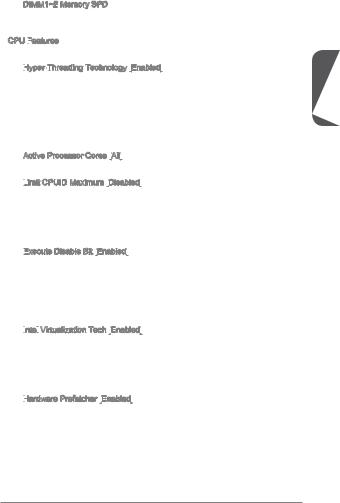
DIMM1~2 Memory SPD
Press <Enter> to enter the sub-menu. The sub-menu displays the information of installed memory. Read only.
CPU Features

Press <Enter> to enter the sub-menu.
Hyper

 -Threading
-Threading
 Technology [Enabled]
Technology [Enabled]



The processor uses Hyper-Threading technology to increase transaction rates and reduces end-user response times. Intel Hyper-Threading technology treats the multi cores inside the processor as multi logical processors that can execute instructions simultaneously. In this way, the system performance is highly improved.
[Enable] |
Enables Intel Hyper-Threading technology. |
[Disabled] |
Disables this item if the system does not support HT function. |
Active Processor Cores [All]



This item allows you to select the number of active processor cores.
Limit
 CPUID Maximum [Disabled]
CPUID Maximum [Disabled]



Enables or disables the extended CPUID value.
[Enabled] |
BIOS will limit the maximum CPUID input value to circumvent |
|
boot problems with older operating system that do not support |
|
the processor with extended CPUID value. |
[Disabled] |
Use the actual maximum CPUID input value. |
Execute
 Disable Bit [Enabled]
Disable Bit [Enabled]



Intel’s Execute Disable Bit functionality can prevent certain classes of malicious “buffer overflow” attacks where worms attempt to execute code to damage the system. It is recommended that keeps this item enabled always.
[Enabled] |
Enables NO-Execution protection to prevent the malicious |
|
attacks and worms. |
[Disabled] |
Disables this function. |
Intel


 Virtualization Tech [Enabled]
Virtualization Tech [Enabled]

Enables or disables Intel Virtualization technology.
[Enabled] |
Enables Intel Virtualization technology and allows a platform |
|
to run multiple operating systems in independent partitions. |
|
The system can function as multiple systems virtually. |
[Disabled] |
Disables this function. |
Hardware
 Prefetcher [Enabled]
Prefetcher [Enabled]



Enables or disables the hardware prefetcher (MLC Streamer prefetcher).
[Enabled] |
Allows the hardware prefetcher to automatically pre-fetch |
|
data and instructions into L2 cache from memory for tuning |
|
the CPU performance. |
[Disabled] |
Disables the hardware prefetcher. |
English
29
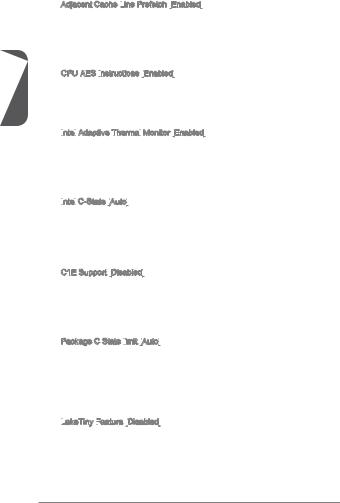
English
Adjacent Cache Line
 Prefetch [Enabled]
Prefetch [Enabled]



Enables or disables the CPU hardware prefetcher (MLC Spatial prefetcher).
[Enabled] |
Enables adjacent cache line prefetching for reducing the |
|
cache latency time and tuning the performance to the specific |
|
application. |
[Disabled] |
Enables the requested cache line only. |
CPU AES Instructions
 [Enabled]
[Enabled]



Enables or disables the CPU AES (Advanced Encryption Standard-New Instructions) support. This item appears when a CPU supports this function.
[Enabled] |
Enables Intel AES support. |
[Disabled] |
Disables Intel AES support. |
Intel


 Adaptive Thermal
Adaptive Thermal

 Monitor [Enabled]
Monitor [Enabled]



Enables or disables the Intel adaptive thermal monitor function to protect the CPU from overheating.
[Enabled] |
Throttles down the CPU core clock speed when the CPU is |
|
over the adaptive temperature. |
[Disabled] |
Disables this function. |
Intel


 C-State [Auto]
C-State [Auto]



C-state is a processor power management technology defined by ACPI.
[Auto] |
This setting will be configured automatically by BIOS. |
[Enabled] |
Detects the idle state of system and reduce CPU power |
|
consumption accordingly. |
[Disabled] |
Disable this function. |
C1E Support [Disabled]



Enables or disables the C1E function for power-saving in halt state. This item appears when "Intel C-State" is enabled.
[Enabled] |
Enables C1E function to reduce the CPU frequency and |
|
voltage for power-saving in halt state. |
[Disabled] |
Disables this function. |
Package C State limit

 [Auto]
[Auto]



This item allows you to select a CPU C-state mode for power-saving when system is idle. This item appears when "Intel C-State" is enabled.
[Auto] |
This setting will be configured automatically by BIOS. |
[C0~C7s] |
The power-saving level from high to low is C7s, C7, C6, C3, |
|
C2, then C0. |
[No limit] |
No c-state limit for CPU. |
LakeTiny
 Feature
Feature
 [Disabled]
[Disabled]



Enables or disables Intel Lake Tiny feature with iRST for SSD. This item appears when a installed CPU supports this function and "Intel C-State" is enabled.
[Enabled] |
Enhance the dynamic IO load adjusted performance for |
|
accelerating the SSD speed. |
[Disabled] |
Disables this feature. |
30
